PC4LC24O: Examining Determinants of Health & Well-being - LSST
VerifiedAdded on 2023/06/18
|11
|3264
|409
Essay
AI Summary
This essay provides a comprehensive analysis of the determinants of health and well-being, focusing on biological, social, and environmental factors at both individual and group levels. It delves into the national and international significance of each determinant, examining their influence on different groups and addressing related inequality and equity issues. The essay references the World Health Organization (WHO) definition of health determinants and differentiates between health inequality and inequity, highlighting the role of lifestyle, genetics, and environmental conditions. Specific examples such as the impact of air pollution, the effects of aging, and the importance of diet are discussed, along with public health interventions like the UK's 'Clean Air Zones' and dietary guidelines. The essay concludes by emphasizing the complex interplay of these factors in shaping the health and well-being of communities.
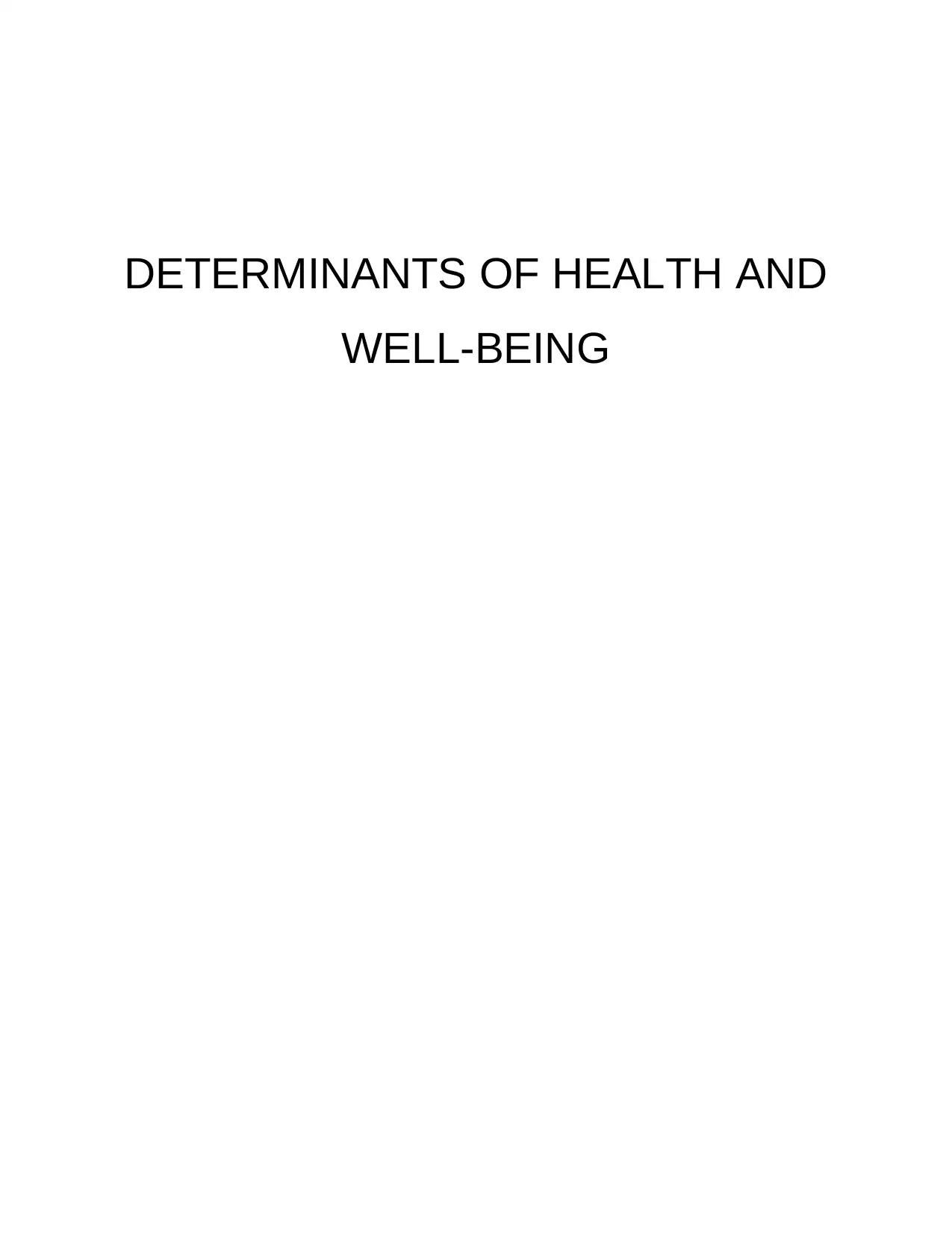
DETERMINANTS OF HEALTH AND
WELL-BEING
WELL-BEING
Paraphrase This Document
Need a fresh take? Get an instant paraphrase of this document with our AI Paraphraser
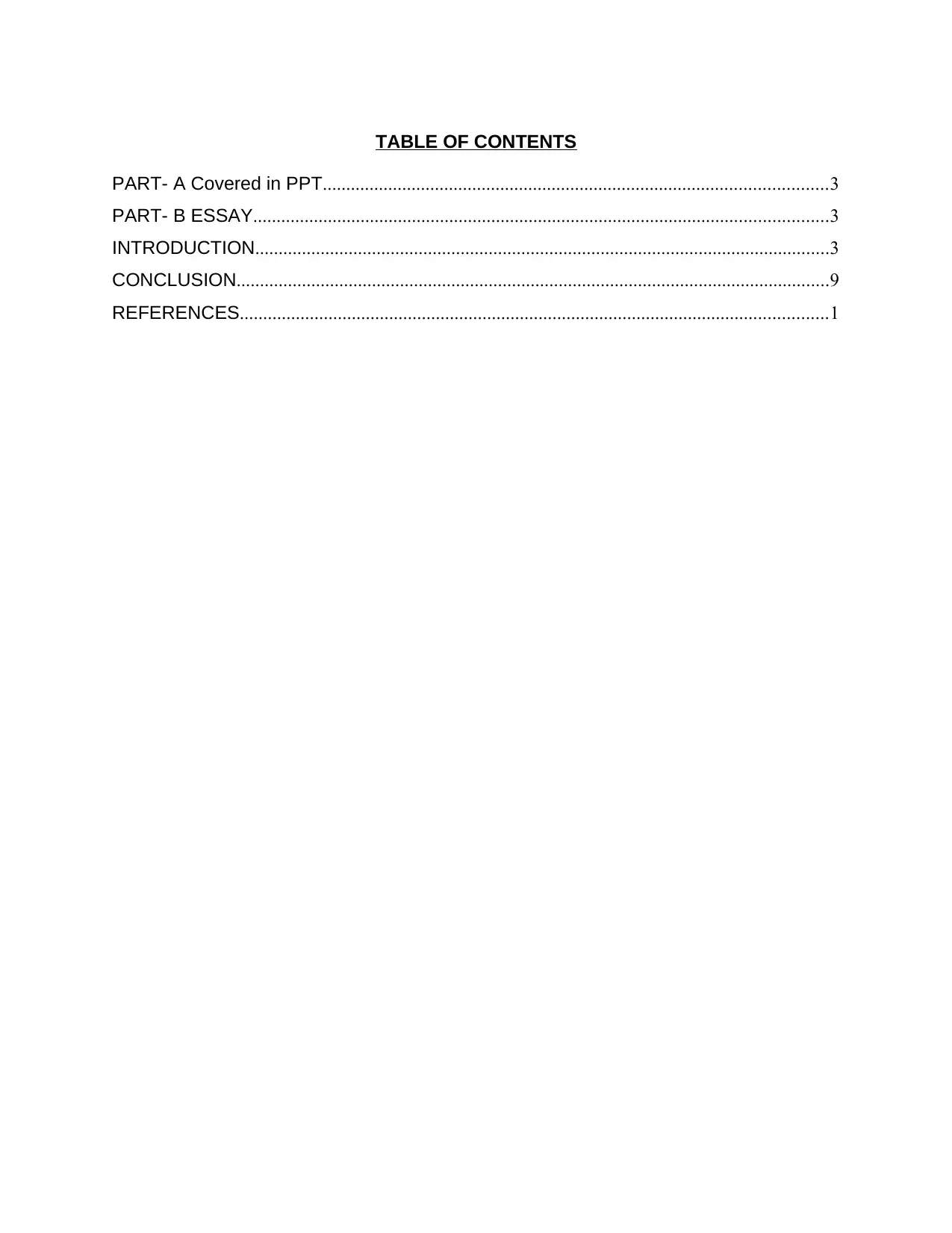
TABLE OF CONTENTS
PART- A Covered in PPT............................................................................................................3
PART- B ESSAY...........................................................................................................................3
INTRODUCTION...........................................................................................................................3
CONCLUSION...............................................................................................................................9
REFERENCES..............................................................................................................................1
PART- A Covered in PPT............................................................................................................3
PART- B ESSAY...........................................................................................................................3
INTRODUCTION...........................................................................................................................3
CONCLUSION...............................................................................................................................9
REFERENCES..............................................................................................................................1
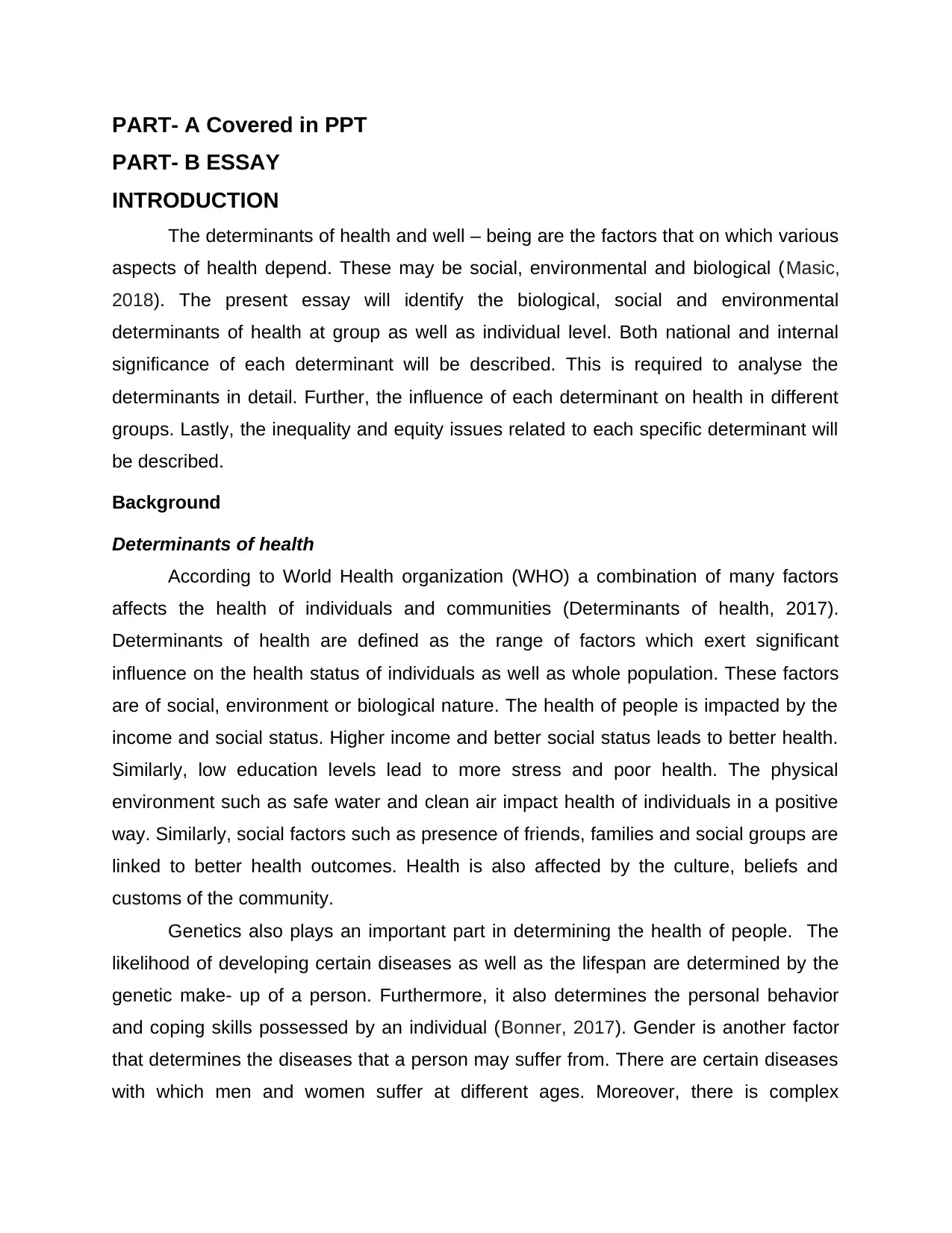
PART- A Covered in PPT
PART- B ESSAY
INTRODUCTION
The determinants of health and well – being are the factors that on which various
aspects of health depend. These may be social, environmental and biological (Masic,
2018). The present essay will identify the biological, social and environmental
determinants of health at group as well as individual level. Both national and internal
significance of each determinant will be described. This is required to analyse the
determinants in detail. Further, the influence of each determinant on health in different
groups. Lastly, the inequality and equity issues related to each specific determinant will
be described.
Background
Determinants of health
According to World Health organization (WHO) a combination of many factors
affects the health of individuals and communities (Determinants of health, 2017).
Determinants of health are defined as the range of factors which exert significant
influence on the health status of individuals as well as whole population. These factors
are of social, environment or biological nature. The health of people is impacted by the
income and social status. Higher income and better social status leads to better health.
Similarly, low education levels lead to more stress and poor health. The physical
environment such as safe water and clean air impact health of individuals in a positive
way. Similarly, social factors such as presence of friends, families and social groups are
linked to better health outcomes. Health is also affected by the culture, beliefs and
customs of the community.
Genetics also plays an important part in determining the health of people. The
likelihood of developing certain diseases as well as the lifespan are determined by the
genetic make- up of a person. Furthermore, it also determines the personal behavior
and coping skills possessed by an individual (Bonner, 2017). Gender is another factor
that determines the diseases that a person may suffer from. There are certain diseases
with which men and women suffer at different ages. Moreover, there is complex
PART- B ESSAY
INTRODUCTION
The determinants of health and well – being are the factors that on which various
aspects of health depend. These may be social, environmental and biological (Masic,
2018). The present essay will identify the biological, social and environmental
determinants of health at group as well as individual level. Both national and internal
significance of each determinant will be described. This is required to analyse the
determinants in detail. Further, the influence of each determinant on health in different
groups. Lastly, the inequality and equity issues related to each specific determinant will
be described.
Background
Determinants of health
According to World Health organization (WHO) a combination of many factors
affects the health of individuals and communities (Determinants of health, 2017).
Determinants of health are defined as the range of factors which exert significant
influence on the health status of individuals as well as whole population. These factors
are of social, environment or biological nature. The health of people is impacted by the
income and social status. Higher income and better social status leads to better health.
Similarly, low education levels lead to more stress and poor health. The physical
environment such as safe water and clean air impact health of individuals in a positive
way. Similarly, social factors such as presence of friends, families and social groups are
linked to better health outcomes. Health is also affected by the culture, beliefs and
customs of the community.
Genetics also plays an important part in determining the health of people. The
likelihood of developing certain diseases as well as the lifespan are determined by the
genetic make- up of a person. Furthermore, it also determines the personal behavior
and coping skills possessed by an individual (Bonner, 2017). Gender is another factor
that determines the diseases that a person may suffer from. There are certain diseases
with which men and women suffer at different ages. Moreover, there is complex
⊘ This is a preview!⊘
Do you want full access?
Subscribe today to unlock all pages.

Trusted by 1+ million students worldwide
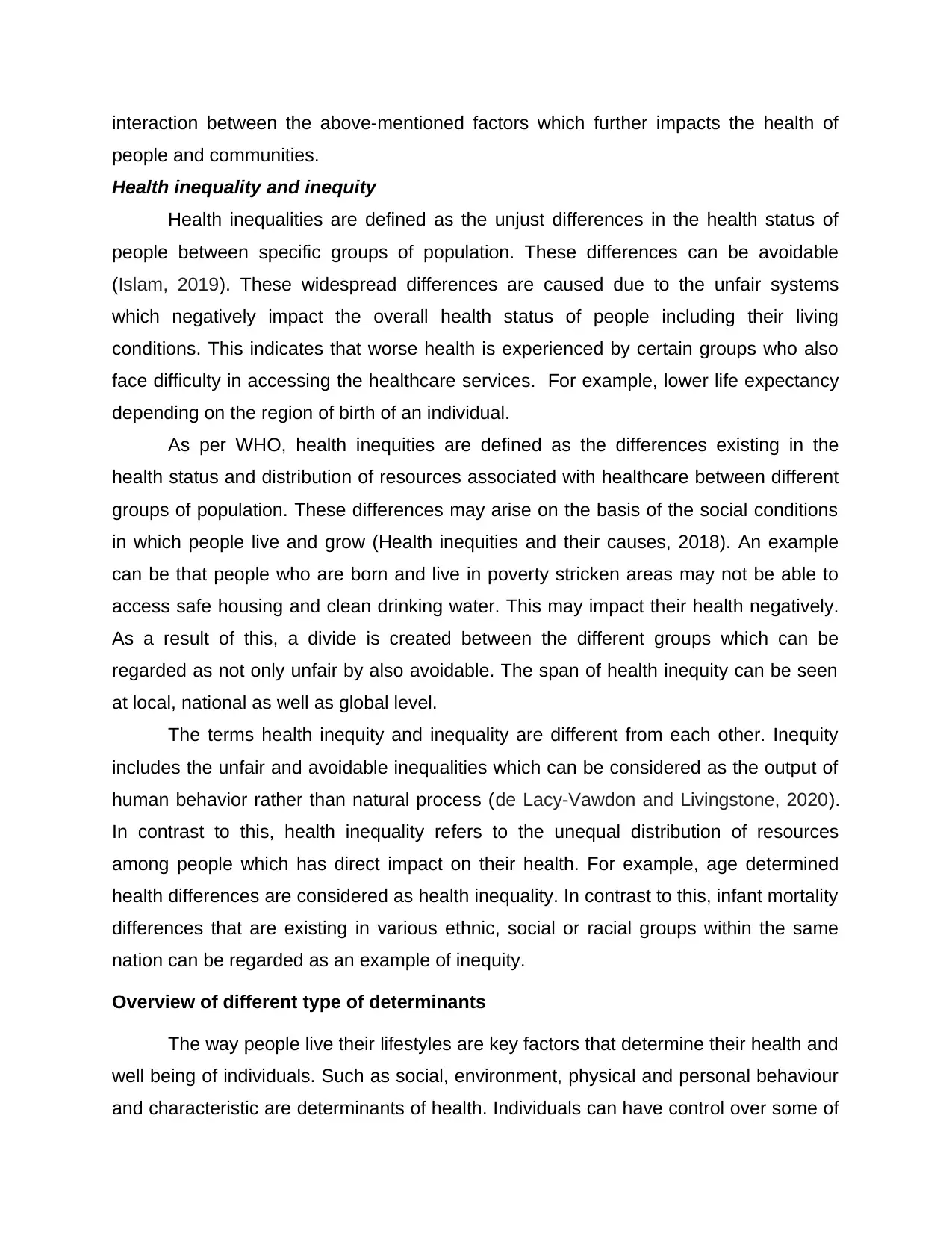
interaction between the above-mentioned factors which further impacts the health of
people and communities.
Health inequality and inequity
Health inequalities are defined as the unjust differences in the health status of
people between specific groups of population. These differences can be avoidable
(Islam, 2019). These widespread differences are caused due to the unfair systems
which negatively impact the overall health status of people including their living
conditions. This indicates that worse health is experienced by certain groups who also
face difficulty in accessing the healthcare services. For example, lower life expectancy
depending on the region of birth of an individual.
As per WHO, health inequities are defined as the differences existing in the
health status and distribution of resources associated with healthcare between different
groups of population. These differences may arise on the basis of the social conditions
in which people live and grow (Health inequities and their causes, 2018). An example
can be that people who are born and live in poverty stricken areas may not be able to
access safe housing and clean drinking water. This may impact their health negatively.
As a result of this, a divide is created between the different groups which can be
regarded as not only unfair by also avoidable. The span of health inequity can be seen
at local, national as well as global level.
The terms health inequity and inequality are different from each other. Inequity
includes the unfair and avoidable inequalities which can be considered as the output of
human behavior rather than natural process (de Lacy-Vawdon and Livingstone, 2020).
In contrast to this, health inequality refers to the unequal distribution of resources
among people which has direct impact on their health. For example, age determined
health differences are considered as health inequality. In contrast to this, infant mortality
differences that are existing in various ethnic, social or racial groups within the same
nation can be regarded as an example of inequity.
Overview of different type of determinants
The way people live their lifestyles are key factors that determine their health and
well being of individuals. Such as social, environment, physical and personal behaviour
and characteristic are determinants of health. Individuals can have control over some of
people and communities.
Health inequality and inequity
Health inequalities are defined as the unjust differences in the health status of
people between specific groups of population. These differences can be avoidable
(Islam, 2019). These widespread differences are caused due to the unfair systems
which negatively impact the overall health status of people including their living
conditions. This indicates that worse health is experienced by certain groups who also
face difficulty in accessing the healthcare services. For example, lower life expectancy
depending on the region of birth of an individual.
As per WHO, health inequities are defined as the differences existing in the
health status and distribution of resources associated with healthcare between different
groups of population. These differences may arise on the basis of the social conditions
in which people live and grow (Health inequities and their causes, 2018). An example
can be that people who are born and live in poverty stricken areas may not be able to
access safe housing and clean drinking water. This may impact their health negatively.
As a result of this, a divide is created between the different groups which can be
regarded as not only unfair by also avoidable. The span of health inequity can be seen
at local, national as well as global level.
The terms health inequity and inequality are different from each other. Inequity
includes the unfair and avoidable inequalities which can be considered as the output of
human behavior rather than natural process (de Lacy-Vawdon and Livingstone, 2020).
In contrast to this, health inequality refers to the unequal distribution of resources
among people which has direct impact on their health. For example, age determined
health differences are considered as health inequality. In contrast to this, infant mortality
differences that are existing in various ethnic, social or racial groups within the same
nation can be regarded as an example of inequity.
Overview of different type of determinants
The way people live their lifestyles are key factors that determine their health and
well being of individuals. Such as social, environment, physical and personal behaviour
and characteristic are determinants of health. Individuals can have control over some of
Paraphrase This Document
Need a fresh take? Get an instant paraphrase of this document with our AI Paraphraser
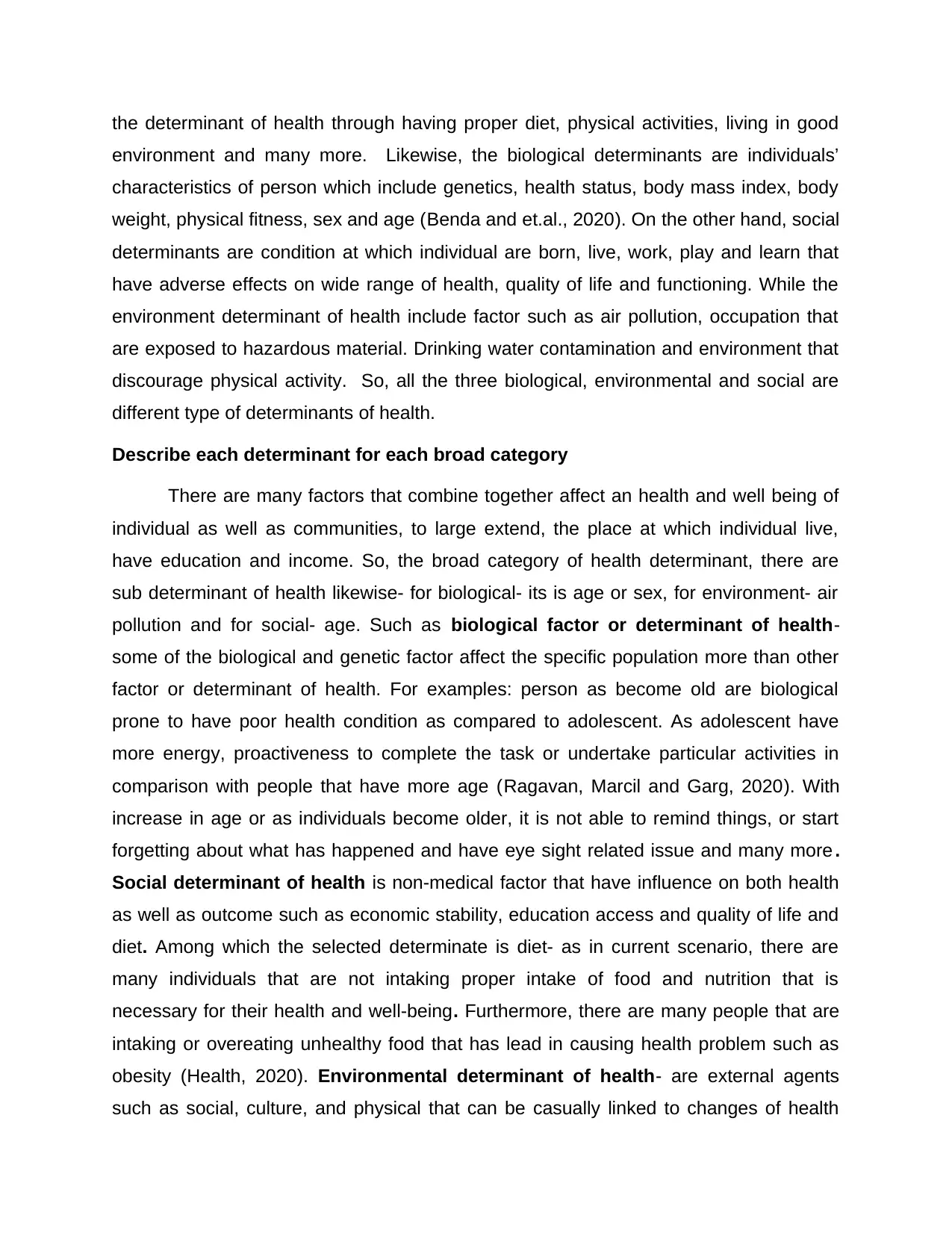
the determinant of health through having proper diet, physical activities, living in good
environment and many more. Likewise, the biological determinants are individuals’
characteristics of person which include genetics, health status, body mass index, body
weight, physical fitness, sex and age (Benda and et.al., 2020). On the other hand, social
determinants are condition at which individual are born, live, work, play and learn that
have adverse effects on wide range of health, quality of life and functioning. While the
environment determinant of health include factor such as air pollution, occupation that
are exposed to hazardous material. Drinking water contamination and environment that
discourage physical activity. So, all the three biological, environmental and social are
different type of determinants of health.
Describe each determinant for each broad category
There are many factors that combine together affect an health and well being of
individual as well as communities, to large extend, the place at which individual live,
have education and income. So, the broad category of health determinant, there are
sub determinant of health likewise- for biological- its is age or sex, for environment- air
pollution and for social- age. Such as biological factor or determinant of health-
some of the biological and genetic factor affect the specific population more than other
factor or determinant of health. For examples: person as become old are biological
prone to have poor health condition as compared to adolescent. As adolescent have
more energy, proactiveness to complete the task or undertake particular activities in
comparison with people that have more age (Ragavan, Marcil and Garg, 2020). With
increase in age or as individuals become older, it is not able to remind things, or start
forgetting about what has happened and have eye sight related issue and many more .
Social determinant of health is non-medical factor that have influence on both health
as well as outcome such as economic stability, education access and quality of life and
diet. Among which the selected determinate is diet- as in current scenario, there are
many individuals that are not intaking proper intake of food and nutrition that is
necessary for their health and well-being. Furthermore, there are many people that are
intaking or overeating unhealthy food that has lead in causing health problem such as
obesity (Health, 2020). Environmental determinant of health- are external agents
such as social, culture, and physical that can be casually linked to changes of health
environment and many more. Likewise, the biological determinants are individuals’
characteristics of person which include genetics, health status, body mass index, body
weight, physical fitness, sex and age (Benda and et.al., 2020). On the other hand, social
determinants are condition at which individual are born, live, work, play and learn that
have adverse effects on wide range of health, quality of life and functioning. While the
environment determinant of health include factor such as air pollution, occupation that
are exposed to hazardous material. Drinking water contamination and environment that
discourage physical activity. So, all the three biological, environmental and social are
different type of determinants of health.
Describe each determinant for each broad category
There are many factors that combine together affect an health and well being of
individual as well as communities, to large extend, the place at which individual live,
have education and income. So, the broad category of health determinant, there are
sub determinant of health likewise- for biological- its is age or sex, for environment- air
pollution and for social- age. Such as biological factor or determinant of health-
some of the biological and genetic factor affect the specific population more than other
factor or determinant of health. For examples: person as become old are biological
prone to have poor health condition as compared to adolescent. As adolescent have
more energy, proactiveness to complete the task or undertake particular activities in
comparison with people that have more age (Ragavan, Marcil and Garg, 2020). With
increase in age or as individuals become older, it is not able to remind things, or start
forgetting about what has happened and have eye sight related issue and many more .
Social determinant of health is non-medical factor that have influence on both health
as well as outcome such as economic stability, education access and quality of life and
diet. Among which the selected determinate is diet- as in current scenario, there are
many individuals that are not intaking proper intake of food and nutrition that is
necessary for their health and well-being. Furthermore, there are many people that are
intaking or overeating unhealthy food that has lead in causing health problem such as
obesity (Health, 2020). Environmental determinant of health- are external agents
such as social, culture, and physical that can be casually linked to changes of health
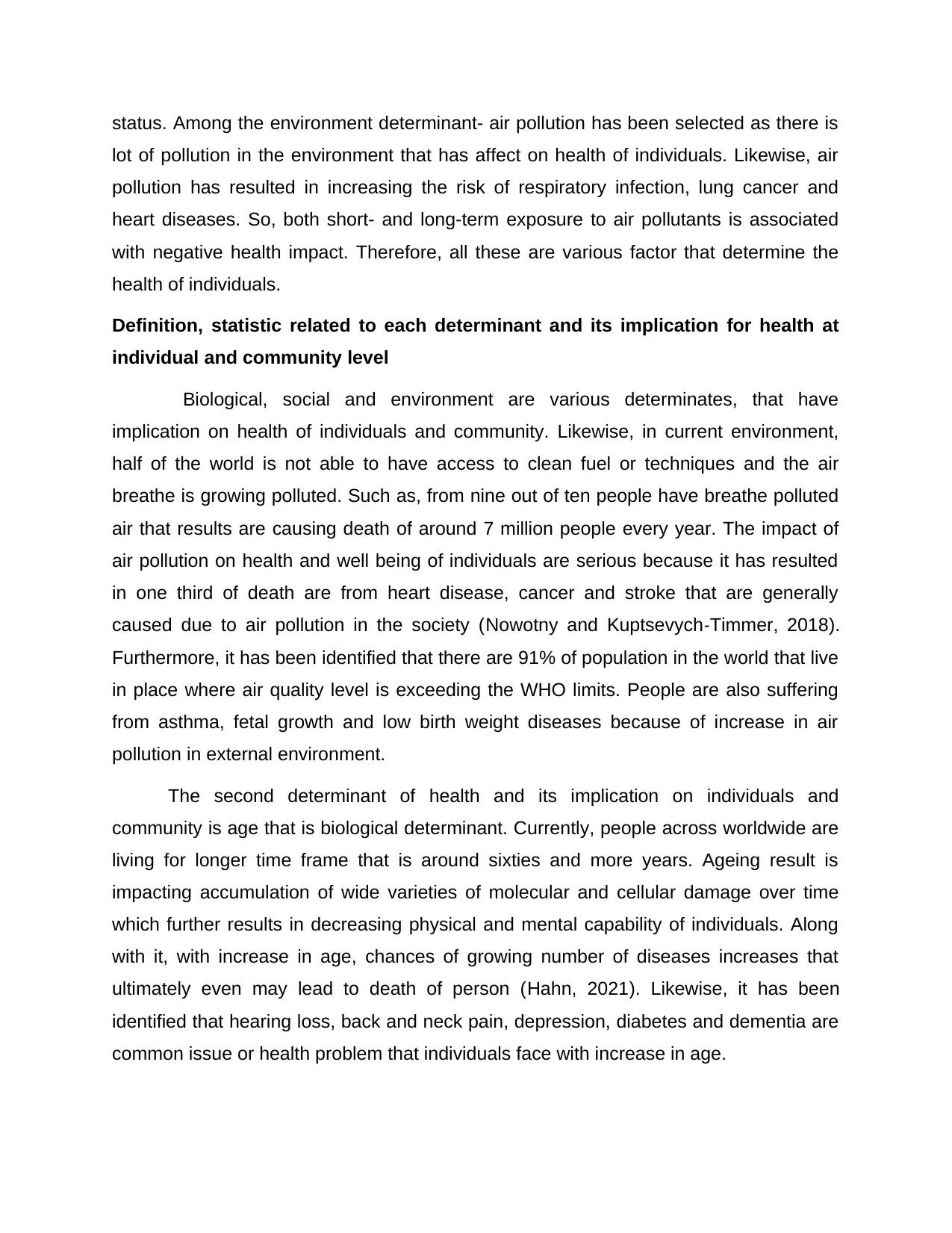
status. Among the environment determinant- air pollution has been selected as there is
lot of pollution in the environment that has affect on health of individuals. Likewise, air
pollution has resulted in increasing the risk of respiratory infection, lung cancer and
heart diseases. So, both short- and long-term exposure to air pollutants is associated
with negative health impact. Therefore, all these are various factor that determine the
health of individuals.
Definition, statistic related to each determinant and its implication for health at
individual and community level
Biological, social and environment are various determinates, that have
implication on health of individuals and community. Likewise, in current environment,
half of the world is not able to have access to clean fuel or techniques and the air
breathe is growing polluted. Such as, from nine out of ten people have breathe polluted
air that results are causing death of around 7 million people every year. The impact of
air pollution on health and well being of individuals are serious because it has resulted
in one third of death are from heart disease, cancer and stroke that are generally
caused due to air pollution in the society (Nowotny and Kuptsevych‐Timmer, 2018).
Furthermore, it has been identified that there are 91% of population in the world that live
in place where air quality level is exceeding the WHO limits. People are also suffering
from asthma, fetal growth and low birth weight diseases because of increase in air
pollution in external environment.
The second determinant of health and its implication on individuals and
community is age that is biological determinant. Currently, people across worldwide are
living for longer time frame that is around sixties and more years. Ageing result is
impacting accumulation of wide varieties of molecular and cellular damage over time
which further results in decreasing physical and mental capability of individuals. Along
with it, with increase in age, chances of growing number of diseases increases that
ultimately even may lead to death of person (Hahn, 2021). Likewise, it has been
identified that hearing loss, back and neck pain, depression, diabetes and dementia are
common issue or health problem that individuals face with increase in age.
lot of pollution in the environment that has affect on health of individuals. Likewise, air
pollution has resulted in increasing the risk of respiratory infection, lung cancer and
heart diseases. So, both short- and long-term exposure to air pollutants is associated
with negative health impact. Therefore, all these are various factor that determine the
health of individuals.
Definition, statistic related to each determinant and its implication for health at
individual and community level
Biological, social and environment are various determinates, that have
implication on health of individuals and community. Likewise, in current environment,
half of the world is not able to have access to clean fuel or techniques and the air
breathe is growing polluted. Such as, from nine out of ten people have breathe polluted
air that results are causing death of around 7 million people every year. The impact of
air pollution on health and well being of individuals are serious because it has resulted
in one third of death are from heart disease, cancer and stroke that are generally
caused due to air pollution in the society (Nowotny and Kuptsevych‐Timmer, 2018).
Furthermore, it has been identified that there are 91% of population in the world that live
in place where air quality level is exceeding the WHO limits. People are also suffering
from asthma, fetal growth and low birth weight diseases because of increase in air
pollution in external environment.
The second determinant of health and its implication on individuals and
community is age that is biological determinant. Currently, people across worldwide are
living for longer time frame that is around sixties and more years. Ageing result is
impacting accumulation of wide varieties of molecular and cellular damage over time
which further results in decreasing physical and mental capability of individuals. Along
with it, with increase in age, chances of growing number of diseases increases that
ultimately even may lead to death of person (Hahn, 2021). Likewise, it has been
identified that hearing loss, back and neck pain, depression, diabetes and dementia are
common issue or health problem that individuals face with increase in age.
⊘ This is a preview!⊘
Do you want full access?
Subscribe today to unlock all pages.

Trusted by 1+ million students worldwide
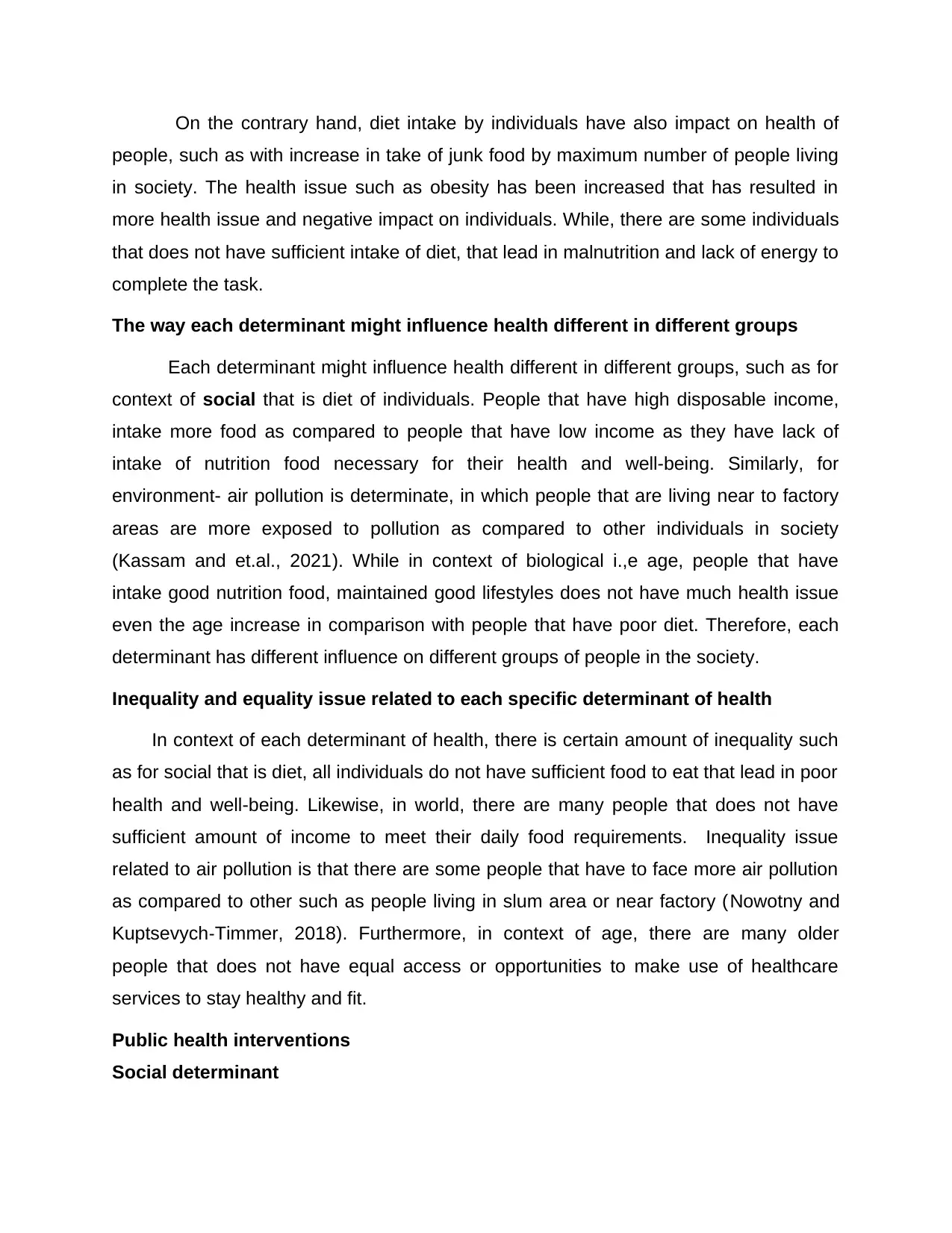
On the contrary hand, diet intake by individuals have also impact on health of
people, such as with increase in take of junk food by maximum number of people living
in society. The health issue such as obesity has been increased that has resulted in
more health issue and negative impact on individuals. While, there are some individuals
that does not have sufficient intake of diet, that lead in malnutrition and lack of energy to
complete the task.
The way each determinant might influence health different in different groups
Each determinant might influence health different in different groups, such as for
context of social that is diet of individuals. People that have high disposable income,
intake more food as compared to people that have low income as they have lack of
intake of nutrition food necessary for their health and well-being. Similarly, for
environment- air pollution is determinate, in which people that are living near to factory
areas are more exposed to pollution as compared to other individuals in society
(Kassam and et.al., 2021). While in context of biological i.,e age, people that have
intake good nutrition food, maintained good lifestyles does not have much health issue
even the age increase in comparison with people that have poor diet. Therefore, each
determinant has different influence on different groups of people in the society.
Inequality and equality issue related to each specific determinant of health
In context of each determinant of health, there is certain amount of inequality such
as for social that is diet, all individuals do not have sufficient food to eat that lead in poor
health and well-being. Likewise, in world, there are many people that does not have
sufficient amount of income to meet their daily food requirements. Inequality issue
related to air pollution is that there are some people that have to face more air pollution
as compared to other such as people living in slum area or near factory (Nowotny and
Kuptsevych‐Timmer, 2018). Furthermore, in context of age, there are many older
people that does not have equal access or opportunities to make use of healthcare
services to stay healthy and fit.
Public health interventions
Social determinant
people, such as with increase in take of junk food by maximum number of people living
in society. The health issue such as obesity has been increased that has resulted in
more health issue and negative impact on individuals. While, there are some individuals
that does not have sufficient intake of diet, that lead in malnutrition and lack of energy to
complete the task.
The way each determinant might influence health different in different groups
Each determinant might influence health different in different groups, such as for
context of social that is diet of individuals. People that have high disposable income,
intake more food as compared to people that have low income as they have lack of
intake of nutrition food necessary for their health and well-being. Similarly, for
environment- air pollution is determinate, in which people that are living near to factory
areas are more exposed to pollution as compared to other individuals in society
(Kassam and et.al., 2021). While in context of biological i.,e age, people that have
intake good nutrition food, maintained good lifestyles does not have much health issue
even the age increase in comparison with people that have poor diet. Therefore, each
determinant has different influence on different groups of people in the society.
Inequality and equality issue related to each specific determinant of health
In context of each determinant of health, there is certain amount of inequality such
as for social that is diet, all individuals do not have sufficient food to eat that lead in poor
health and well-being. Likewise, in world, there are many people that does not have
sufficient amount of income to meet their daily food requirements. Inequality issue
related to air pollution is that there are some people that have to face more air pollution
as compared to other such as people living in slum area or near factory (Nowotny and
Kuptsevych‐Timmer, 2018). Furthermore, in context of age, there are many older
people that does not have equal access or opportunities to make use of healthcare
services to stay healthy and fit.
Public health interventions
Social determinant
Paraphrase This Document
Need a fresh take? Get an instant paraphrase of this document with our AI Paraphraser
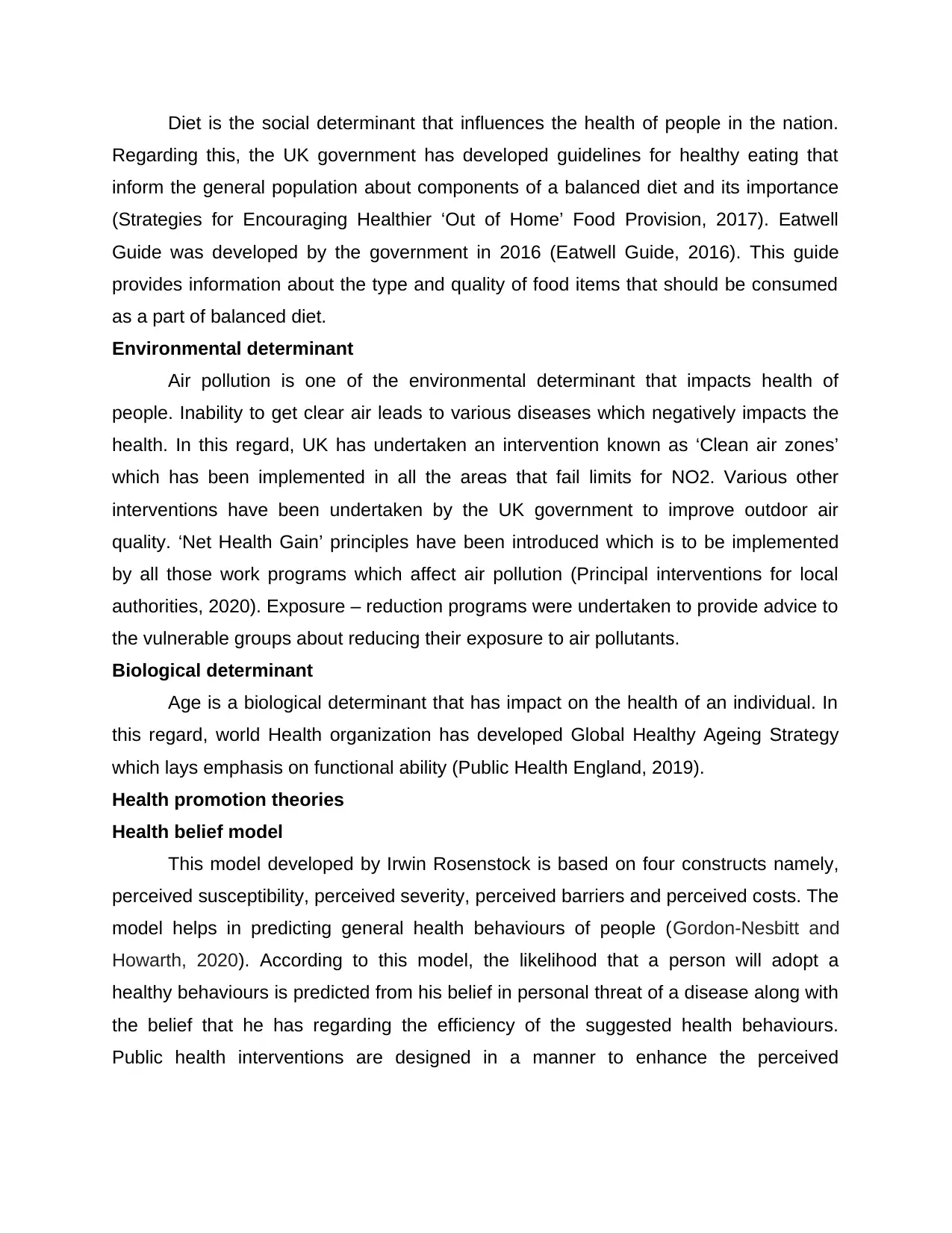
Diet is the social determinant that influences the health of people in the nation.
Regarding this, the UK government has developed guidelines for healthy eating that
inform the general population about components of a balanced diet and its importance
(Strategies for Encouraging Healthier ‘Out of Home’ Food Provision, 2017). Eatwell
Guide was developed by the government in 2016 (Eatwell Guide, 2016). This guide
provides information about the type and quality of food items that should be consumed
as a part of balanced diet.
Environmental determinant
Air pollution is one of the environmental determinant that impacts health of
people. Inability to get clear air leads to various diseases which negatively impacts the
health. In this regard, UK has undertaken an intervention known as ‘Clean air zones’
which has been implemented in all the areas that fail limits for NO2. Various other
interventions have been undertaken by the UK government to improve outdoor air
quality. ‘Net Health Gain’ principles have been introduced which is to be implemented
by all those work programs which affect air pollution (Principal interventions for local
authorities, 2020). Exposure – reduction programs were undertaken to provide advice to
the vulnerable groups about reducing their exposure to air pollutants.
Biological determinant
Age is a biological determinant that has impact on the health of an individual. In
this regard, world Health organization has developed Global Healthy Ageing Strategy
which lays emphasis on functional ability (Public Health England, 2019).
Health promotion theories
Health belief model
This model developed by Irwin Rosenstock is based on four constructs namely,
perceived susceptibility, perceived severity, perceived barriers and perceived costs. The
model helps in predicting general health behaviours of people (Gordon-Nesbitt and
Howarth, 2020). According to this model, the likelihood that a person will adopt a
healthy behaviours is predicted from his belief in personal threat of a disease along with
the belief that he has regarding the efficiency of the suggested health behaviours.
Public health interventions are designed in a manner to enhance the perceived
Regarding this, the UK government has developed guidelines for healthy eating that
inform the general population about components of a balanced diet and its importance
(Strategies for Encouraging Healthier ‘Out of Home’ Food Provision, 2017). Eatwell
Guide was developed by the government in 2016 (Eatwell Guide, 2016). This guide
provides information about the type and quality of food items that should be consumed
as a part of balanced diet.
Environmental determinant
Air pollution is one of the environmental determinant that impacts health of
people. Inability to get clear air leads to various diseases which negatively impacts the
health. In this regard, UK has undertaken an intervention known as ‘Clean air zones’
which has been implemented in all the areas that fail limits for NO2. Various other
interventions have been undertaken by the UK government to improve outdoor air
quality. ‘Net Health Gain’ principles have been introduced which is to be implemented
by all those work programs which affect air pollution (Principal interventions for local
authorities, 2020). Exposure – reduction programs were undertaken to provide advice to
the vulnerable groups about reducing their exposure to air pollutants.
Biological determinant
Age is a biological determinant that has impact on the health of an individual. In
this regard, world Health organization has developed Global Healthy Ageing Strategy
which lays emphasis on functional ability (Public Health England, 2019).
Health promotion theories
Health belief model
This model developed by Irwin Rosenstock is based on four constructs namely,
perceived susceptibility, perceived severity, perceived barriers and perceived costs. The
model helps in predicting general health behaviours of people (Gordon-Nesbitt and
Howarth, 2020). According to this model, the likelihood that a person will adopt a
healthy behaviours is predicted from his belief in personal threat of a disease along with
the belief that he has regarding the efficiency of the suggested health behaviours.
Public health interventions are designed in a manner to enhance the perceived
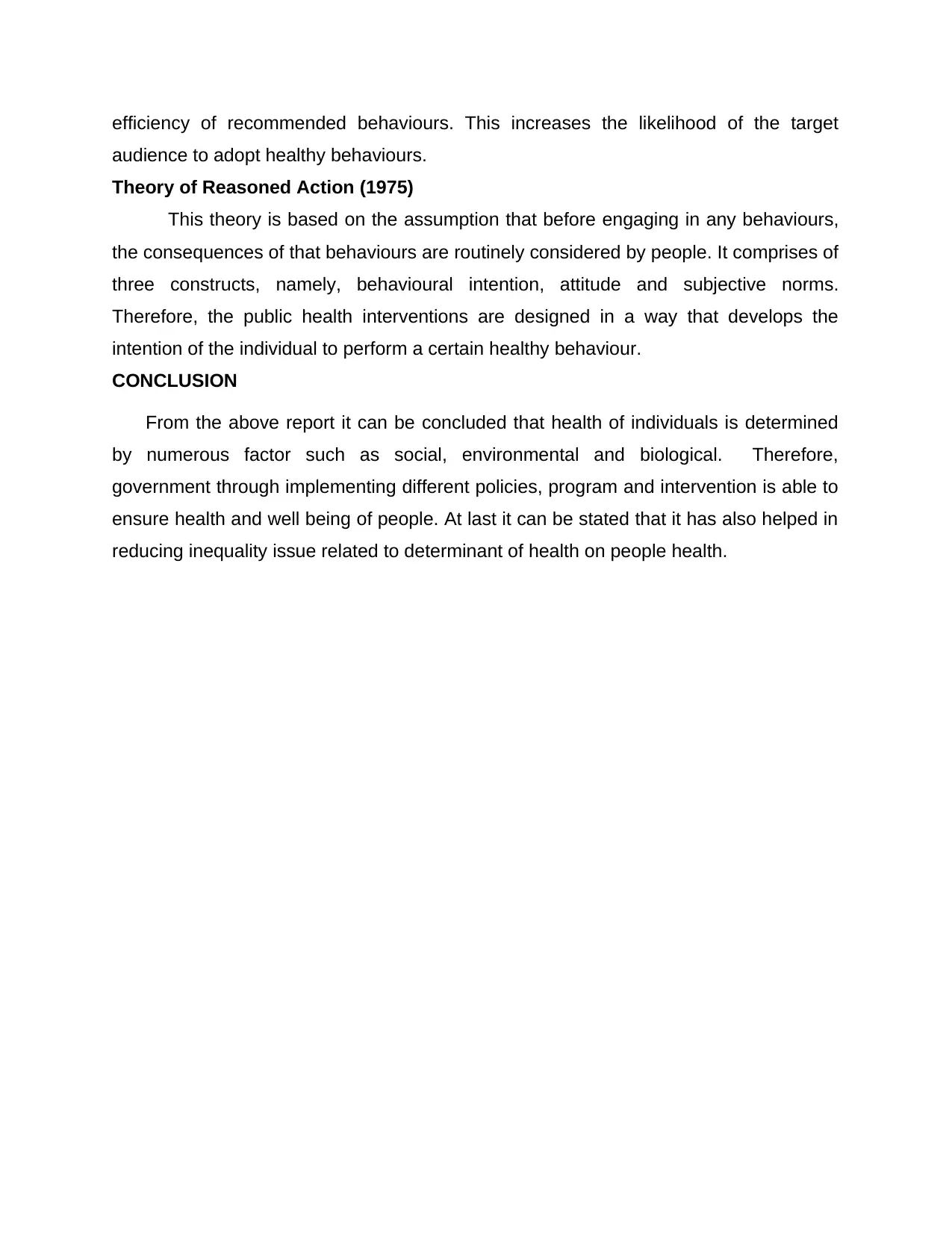
efficiency of recommended behaviours. This increases the likelihood of the target
audience to adopt healthy behaviours.
Theory of Reasoned Action (1975)
This theory is based on the assumption that before engaging in any behaviours,
the consequences of that behaviours are routinely considered by people. It comprises of
three constructs, namely, behavioural intention, attitude and subjective norms.
Therefore, the public health interventions are designed in a way that develops the
intention of the individual to perform a certain healthy behaviour.
CONCLUSION
From the above report it can be concluded that health of individuals is determined
by numerous factor such as social, environmental and biological. Therefore,
government through implementing different policies, program and intervention is able to
ensure health and well being of people. At last it can be stated that it has also helped in
reducing inequality issue related to determinant of health on people health.
audience to adopt healthy behaviours.
Theory of Reasoned Action (1975)
This theory is based on the assumption that before engaging in any behaviours,
the consequences of that behaviours are routinely considered by people. It comprises of
three constructs, namely, behavioural intention, attitude and subjective norms.
Therefore, the public health interventions are designed in a way that develops the
intention of the individual to perform a certain healthy behaviour.
CONCLUSION
From the above report it can be concluded that health of individuals is determined
by numerous factor such as social, environmental and biological. Therefore,
government through implementing different policies, program and intervention is able to
ensure health and well being of people. At last it can be stated that it has also helped in
reducing inequality issue related to determinant of health on people health.
⊘ This is a preview!⊘
Do you want full access?
Subscribe today to unlock all pages.

Trusted by 1+ million students worldwide
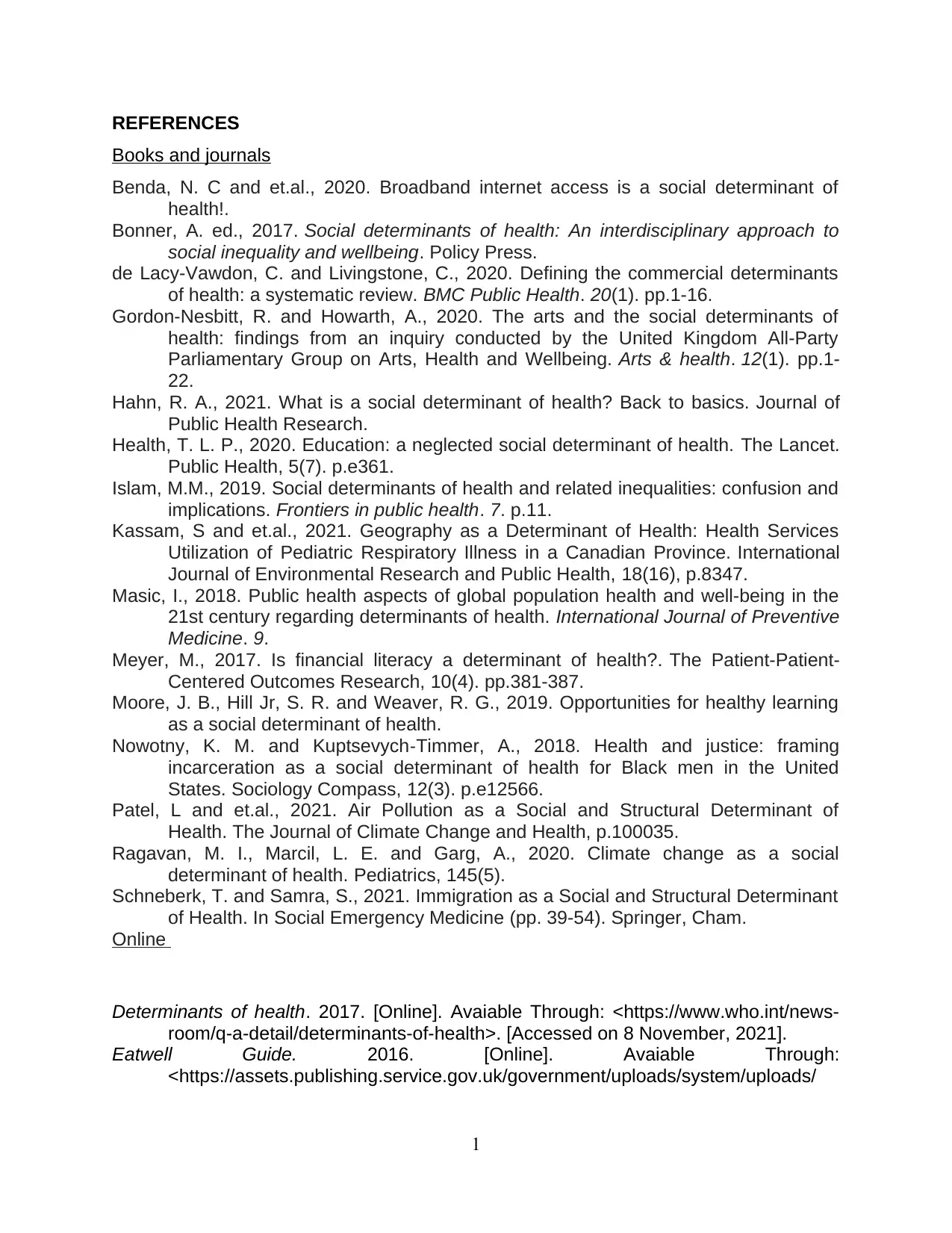
REFERENCES
Books and journals
Benda, N. C and et.al., 2020. Broadband internet access is a social determinant of
health!.
Bonner, A. ed., 2017. Social determinants of health: An interdisciplinary approach to
social inequality and wellbeing. Policy Press.
de Lacy-Vawdon, C. and Livingstone, C., 2020. Defining the commercial determinants
of health: a systematic review. BMC Public Health. 20(1). pp.1-16.
Gordon-Nesbitt, R. and Howarth, A., 2020. The arts and the social determinants of
health: findings from an inquiry conducted by the United Kingdom All-Party
Parliamentary Group on Arts, Health and Wellbeing. Arts & health. 12(1). pp.1-
22.
Hahn, R. A., 2021. What is a social determinant of health? Back to basics. Journal of
Public Health Research.
Health, T. L. P., 2020. Education: a neglected social determinant of health. The Lancet.
Public Health, 5(7). p.e361.
Islam, M.M., 2019. Social determinants of health and related inequalities: confusion and
implications. Frontiers in public health. 7. p.11.
Kassam, S and et.al., 2021. Geography as a Determinant of Health: Health Services
Utilization of Pediatric Respiratory Illness in a Canadian Province. International
Journal of Environmental Research and Public Health, 18(16), p.8347.
Masic, I., 2018. Public health aspects of global population health and well-being in the
21st century regarding determinants of health. International Journal of Preventive
Medicine. 9.
Meyer, M., 2017. Is financial literacy a determinant of health?. The Patient-Patient-
Centered Outcomes Research, 10(4). pp.381-387.
Moore, J. B., Hill Jr, S. R. and Weaver, R. G., 2019. Opportunities for healthy learning
as a social determinant of health.
Nowotny, K. M. and Kuptsevych‐Timmer, A., 2018. Health and justice: framing
incarceration as a social determinant of health for Black men in the United
States. Sociology Compass, 12(3). p.e12566.
Patel, L and et.al., 2021. Air Pollution as a Social and Structural Determinant of
Health. The Journal of Climate Change and Health, p.100035.
Ragavan, M. I., Marcil, L. E. and Garg, A., 2020. Climate change as a social
determinant of health. Pediatrics, 145(5).
Schneberk, T. and Samra, S., 2021. Immigration as a Social and Structural Determinant
of Health. In Social Emergency Medicine (pp. 39-54). Springer, Cham.
Online
Determinants of health. 2017. [Online]. Avaiable Through: <https://www.who.int/news-
room/q-a-detail/determinants-of-health>. [Accessed on 8 November, 2021].
Eatwell Guide. 2016. [Online]. Avaiable Through:
<https://assets.publishing.service.gov.uk/government/uploads/system/uploads/
1
Books and journals
Benda, N. C and et.al., 2020. Broadband internet access is a social determinant of
health!.
Bonner, A. ed., 2017. Social determinants of health: An interdisciplinary approach to
social inequality and wellbeing. Policy Press.
de Lacy-Vawdon, C. and Livingstone, C., 2020. Defining the commercial determinants
of health: a systematic review. BMC Public Health. 20(1). pp.1-16.
Gordon-Nesbitt, R. and Howarth, A., 2020. The arts and the social determinants of
health: findings from an inquiry conducted by the United Kingdom All-Party
Parliamentary Group on Arts, Health and Wellbeing. Arts & health. 12(1). pp.1-
22.
Hahn, R. A., 2021. What is a social determinant of health? Back to basics. Journal of
Public Health Research.
Health, T. L. P., 2020. Education: a neglected social determinant of health. The Lancet.
Public Health, 5(7). p.e361.
Islam, M.M., 2019. Social determinants of health and related inequalities: confusion and
implications. Frontiers in public health. 7. p.11.
Kassam, S and et.al., 2021. Geography as a Determinant of Health: Health Services
Utilization of Pediatric Respiratory Illness in a Canadian Province. International
Journal of Environmental Research and Public Health, 18(16), p.8347.
Masic, I., 2018. Public health aspects of global population health and well-being in the
21st century regarding determinants of health. International Journal of Preventive
Medicine. 9.
Meyer, M., 2017. Is financial literacy a determinant of health?. The Patient-Patient-
Centered Outcomes Research, 10(4). pp.381-387.
Moore, J. B., Hill Jr, S. R. and Weaver, R. G., 2019. Opportunities for healthy learning
as a social determinant of health.
Nowotny, K. M. and Kuptsevych‐Timmer, A., 2018. Health and justice: framing
incarceration as a social determinant of health for Black men in the United
States. Sociology Compass, 12(3). p.e12566.
Patel, L and et.al., 2021. Air Pollution as a Social and Structural Determinant of
Health. The Journal of Climate Change and Health, p.100035.
Ragavan, M. I., Marcil, L. E. and Garg, A., 2020. Climate change as a social
determinant of health. Pediatrics, 145(5).
Schneberk, T. and Samra, S., 2021. Immigration as a Social and Structural Determinant
of Health. In Social Emergency Medicine (pp. 39-54). Springer, Cham.
Online
Determinants of health. 2017. [Online]. Avaiable Through: <https://www.who.int/news-
room/q-a-detail/determinants-of-health>. [Accessed on 8 November, 2021].
Eatwell Guide. 2016. [Online]. Avaiable Through:
<https://assets.publishing.service.gov.uk/government/uploads/system/uploads/
1
Paraphrase This Document
Need a fresh take? Get an instant paraphrase of this document with our AI Paraphraser
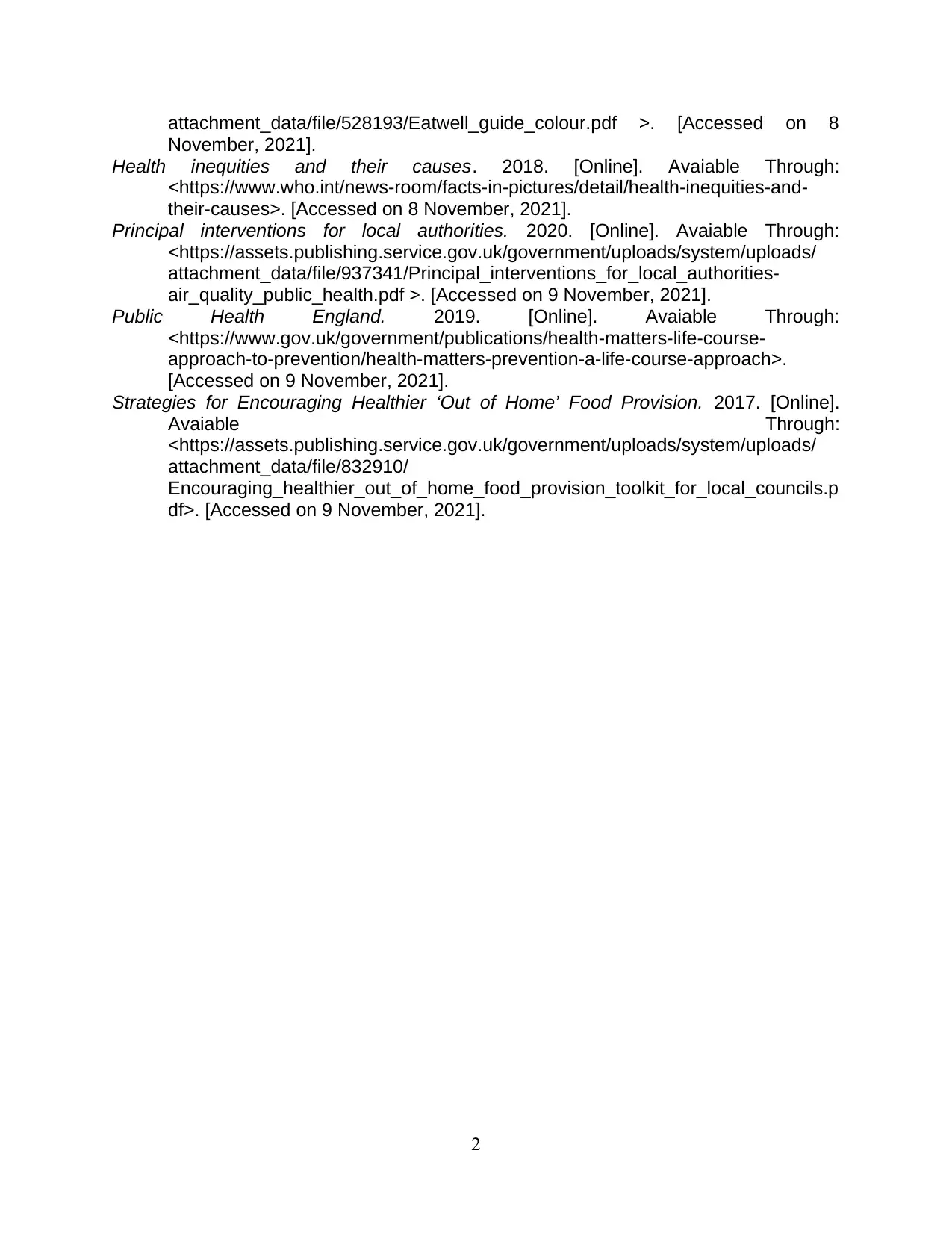
attachment_data/file/528193/Eatwell_guide_colour.pdf >. [Accessed on 8
November, 2021].
Health inequities and their causes. 2018. [Online]. Avaiable Through:
<https://www.who.int/news-room/facts-in-pictures/detail/health-inequities-and-
their-causes>. [Accessed on 8 November, 2021].
Principal interventions for local authorities. 2020. [Online]. Avaiable Through:
<https://assets.publishing.service.gov.uk/government/uploads/system/uploads/
attachment_data/file/937341/Principal_interventions_for_local_authorities-
air_quality_public_health.pdf >. [Accessed on 9 November, 2021].
Public Health England. 2019. [Online]. Avaiable Through:
<https://www.gov.uk/government/publications/health-matters-life-course-
approach-to-prevention/health-matters-prevention-a-life-course-approach>.
[Accessed on 9 November, 2021].
Strategies for Encouraging Healthier ‘Out of Home’ Food Provision. 2017. [Online].
Avaiable Through:
<https://assets.publishing.service.gov.uk/government/uploads/system/uploads/
attachment_data/file/832910/
Encouraging_healthier_out_of_home_food_provision_toolkit_for_local_councils.p
df>. [Accessed on 9 November, 2021].
2
November, 2021].
Health inequities and their causes. 2018. [Online]. Avaiable Through:
<https://www.who.int/news-room/facts-in-pictures/detail/health-inequities-and-
their-causes>. [Accessed on 8 November, 2021].
Principal interventions for local authorities. 2020. [Online]. Avaiable Through:
<https://assets.publishing.service.gov.uk/government/uploads/system/uploads/
attachment_data/file/937341/Principal_interventions_for_local_authorities-
air_quality_public_health.pdf >. [Accessed on 9 November, 2021].
Public Health England. 2019. [Online]. Avaiable Through:
<https://www.gov.uk/government/publications/health-matters-life-course-
approach-to-prevention/health-matters-prevention-a-life-course-approach>.
[Accessed on 9 November, 2021].
Strategies for Encouraging Healthier ‘Out of Home’ Food Provision. 2017. [Online].
Avaiable Through:
<https://assets.publishing.service.gov.uk/government/uploads/system/uploads/
attachment_data/file/832910/
Encouraging_healthier_out_of_home_food_provision_toolkit_for_local_councils.p
df>. [Accessed on 9 November, 2021].
2
1 out of 11
Related Documents
Your All-in-One AI-Powered Toolkit for Academic Success.
+13062052269
info@desklib.com
Available 24*7 on WhatsApp / Email
![[object Object]](/_next/static/media/star-bottom.7253800d.svg)
Unlock your academic potential
Copyright © 2020–2025 A2Z Services. All Rights Reserved. Developed and managed by ZUCOL.



